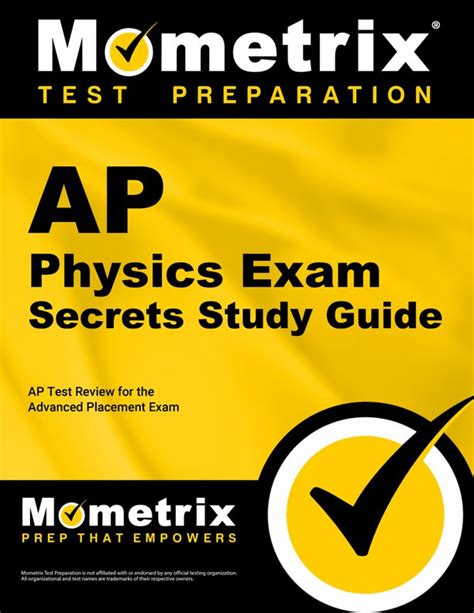Prepare for AP Physics with this comprehensive study guide. Master the key concepts, strategies, and practice questions to excel on exam day.

Prerequisites for AP Physics
Before embarking on AP Physics, students should have a solid foundation in:
- Algebra II
- Trigonometry
- Geometry
- Physics I
Key Concepts and Skills
AP Physics focuses on six major units:
1. Kinematics
- Motion in one and two dimensions
- Velocity and acceleration
- Projectile motion
- Circular motion
2. Dynamics
- Newton’s laws of motion
- Equilibrium
- Momentum
- Energy
3. Energy Conservation
- Types of energy (mechanical, thermal, electrical)
- Conservation of energy
- Work, power, and efficiency
4. Circular Motion and Gravitation
- Kepler’s laws
- Universal gravitation
- Centripetal force
5. Momentum
- Conservation of momentum
- Collisions
- Impulse
6. Simple Harmonic Motion
- Oscillations
- Springs and pendulums
- Resonance
Strategies for Success
1. Active Reading
- Read each chapter twice: once for comprehension and once to highlight key concepts.
- Take notes and summarize important information.
2. Practice Problems
- Solve as many practice problems as possible from various sources (textbook, online, past papers).
- Review your answers and identify areas for improvement.
3. Conceptual Understanding
- Focus on understanding the underlying principles rather than memorizing formulas.
- Draw diagrams and explain the physics behind each concept.
4. Time Management
- Practice taking the exam under timed conditions.
- Learn to allocate your time wisely among different sections.
5. Review and Repetition
- Review material regularly to reinforce learning.
- Spaced repetition techniques can enhance memory retention.
Pros and Cons of AP Physics
Pros:
- Rigorous curriculum that prepares students for college-level physics
- Develops critical thinking, problem-solving, and analysis skills
- Can earn college credit or placement into advanced courses
- Impresses colleges on applications
Cons:
- Can be challenging for students without a strong physics foundation
- Time-consuming to prepare for
- May require additional resources or tutoring for some students
Frequently Asked Questions
1. How much time should I spend preparing for AP Physics?
Most experts recommend spending approximately 5-7 hours per week studying for AP Physics.
2. What is the success rate for AP Physics?
In 2022, the pass rate for AP Physics 1 was 66.7%, and the pass rate for AP Physics 2 was 65.3%.
3. Can I self-study for AP Physics?
While it is possible to self-study for AP Physics, it is generally recommended to have a teacher or tutor for support and guidance.
4. What resources are available for AP Physics?
Numerous resources are available, including textbooks, online courses, practice problems, and past papers.
5. How can I do well on the free-response questions?
Practice writing clear, concise responses that demonstrate your understanding of the concepts and show your ability to apply them to real-world situations.
6. What are some applications of AP Physics in real life?
Concepts from AP Physics are used in fields such as engineering, medicine, astronomy, and energy production.
7. What is the best way to avoid mistakes on the exam?
Carefully read and understand the question, review your work before submitting it, and manage your time effectively to avoid rushing.
8. What should I do if I feel overwhelmed?
Break down the material into smaller chunks, focus on one concept at a time, and seek help from a teacher or tutor when needed.
Practice Questions
Table 1: Kinematics Questions
| Question | Answer |
|---|---|
| A car accelerates from rest to 60 mph in 10 seconds. What is its acceleration? | 9.6 m/s^2 |
| A ball is thrown vertically upward with an initial velocity of 20 m/s. What is its maximum height? | 20.4 meters |
| A satellite orbits the Earth in a circular path of radius 6.4 x 10^6 meters. What is its orbital speed? | 7,900 m/s |
Table 2: Dynamics Questions
| Question | Answer |
|---|---|
| A 10-kg block is pushed with a force of 50 N. What is its acceleration? | 5 m/s^2 |
| Two blocks of masses 2 kg and 5 kg collide head-on with equal speeds. What is the velocity of the 5-kg block after the collision? | 1.67 m/s |
| A spring with a spring constant of 100 N/m is stretched by 0.2 meters. What is the stored elastic potential energy? | 1 Joule |
Table 3: Energy Conservation Questions
| Question | Answer |
|---|---|
| A 100-kg skier starts from rest at the top of a hill. What is its velocity at the bottom of the hill if the height of the hill is 25 meters? | 22.1 m/s |
| A 60-watt light bulb burns for 3 hours. How much electrical energy does it use? | 648,000 Joules |
| A car with a mass of 1,500 kg is traveling at 50 mph. What is its kinetic energy? | 318,750 Joules |
Table 4: Simple Harmonic Motion Questions
| Question | Answer |
|---|---|
| A spring with a mass of 0.5 kg has a spring constant of 200 N/m. What is its natural frequency? | 2 Hz |
| A pendulum with a length of 1 meter swings with an amplitude of 0.1 meters. What is the period of its motion? | 2.01 seconds |
| A mass-spring system is undergoing simple harmonic motion. If the mass is 1 kg and the maximum displacement is 0.2 meters, what is the potential energy at maximum displacement? | 0.2 Joules |
By following these strategies and practicing the concepts covered in this study guide, you can significantly improve your chances of success on the AP Physics exam. Embrace the challenge, stay persistent, and let your passion for physics guide you towards excellence.
